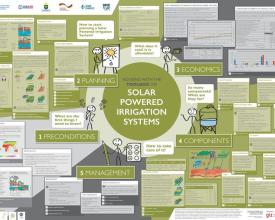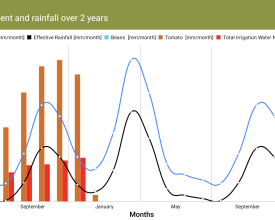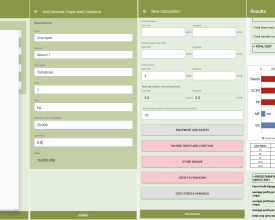
Toolbox on Solar Powered Irrigation Systems (SPIS): Information and Tools for Advising on Solar Water Pumping and Irrigation

Solar pumps have become an economical, technically and environmentally viable alternative to conventional pumping systems powered by engines run on fossil fuels (diesel, petrol, gas) or electricity from the grid, even in the rural areas with limited or no electricity supply.
The Toolbox on SPIS is designed to enable advisors, service providers and practitioners in the field of solar irrigation to provide broad hands-on guidance to end-users, policymakers and financiers. The holistic set of practical knowledge products, that the Toolbox provides, allow the end users to consider the SPIS specific characteristics and minimize the risks related to system efficiency, financial viability and the unsustainable use of water.
The Toolbox comprises informative modules supplemented with user-friendly software tools (calculations sheets, checklists, guidelines) which support users in budgeting, sizing and designing a solar-powered irrigation system. The tools are available in English, French, Spanish and Arabic.
Context
Challenges addressed
The lack of information on solar irrigation and its relatively high investment costs hinder the uptake of the technology. The knowledge on the potential, limitations and risks of the SPIS among extension officers, suppliers, policy makers, financing institutions and other stakeholders needs to be extended. Thus, farmers will have the access to the sound information to take informed decisions and maintain a SPIS in a sustainable way. The Toolbox provides a holistic approach through which the SPIS advisors can guide their clients.
The SPIS Toolbox improves farmers’, advisors’ and system installers’ capacity to sustainably manage water resources in a SPIS. While the access to information on the SPIS, contributes to a wider adoption of the technology and reduced emissions through the use of solar energy instead of fossil fuels to power the pumps.
The Toolbox informs decision-making agencies about the financial option more suitable for farmer needs, so that farmers could access finance for the SPIS.
Location
Process
Summary of the process
It is important to design the SPIS in a way that farmers needs and site specific conditions (their environmental, agronomic and technical aspects) are addressed. This allows to optimize the potential of the technology to avoid negative ecological and economic impacts. The Toolbox fills the knowledge gap by informing extension officers, suppliers, policy makers, financing institutions and other stakeholders on the potential, limitations and risks of Solar Powered Irrigation Systems (SPIS). The Toolbox includes informative modules supplemented with user-friendly software tools (calculations sheets, checklists, guidelines) that provide a holistic set of practical knowledge materials through which SPIS advisors can guide their clients towards a financially and environmentally sound choice that helps to save water, achieve higher productivity per unit of water consumed while providing water for the environment.
Building Blocks
The Pump Sizing Tool
The Pump Sizing Tool allows for the calculation of the pumping head, the required solar PV module capacity, and selects suitable pump technologies. The DESIGN – Pump Sizing Tool helps design the irrigation system so as to ensure that as little pressure as possible is lost in the system. In addition, it serves as a checklist to identify pressure losses, e.g. due to leaks in an existing system.
Enabling factors
Technical support of farmers during the planning phase; data on the daily crop water requirement, mean daily global solar radiation for the design month, country-specific costs of PV panel & pump; availability of financing options
Lesson learned
Proper sizing of the components of an SPIS is critical, since an SPIS with insufficient capacity will not satisfy the farmers’ needs and an over dimensioned system will induce unnecessary operation and capital costs. Negligence of the sustainable water yield of water sources may result in water shortage and a depletion of water resources, thus having negative impacts on the farm budget and the environment. It is therefore very important to be in close contact with the farmer during the planning phase and to inform him about the advantages and limits of SPIS.
The final design of the PV pump and irrigation system should be left to experienced system integrators who use computer-based system sizing and simulation tools such as COMPASS, WinCAPS and PVSYST, HydroCALC, GESTAR.
The Payback Tool
The Payback Tool allows for a comparative assessment between income and three different irrigation pumping options. Information required for using this tool includes investment and operational costs for the different pumping systems, anticipated income from agricultural production, and basic economic conditions (e.g. inflation rate). Even when the profitability of the farming enterprise is confirmed, however, this does not automatically imply that an investment into an SPIS is the most sensible choice. This is especially true if other pumping technologies are readily available on the market. A Diesel or Grid-connected eletric pump might be more feasible where water pumping is only required for a limited time per year. The INVEST – Payback Tool considers and compares solar powered irrigation systems with other pumping technologies. Basic data is collected from technology suppliers and the payback period against the farm profit and the different technologies is automatically calculated.
Enabling factors
Availability of data on the project/SPIS functional lifetime, capital expenditures / initial capital investment for solar and alternative options, market prices, operating and maintenance costs, macroeconomic variables, tax policies; further advice of financial experts
Lesson learned
All calculations need to be based on prices which can be determined but also on estimates and assumptions. They will have to consider the current situation and future scenarios and should compare options for alternative pumping systems (electric, diesel). Different scenarios should be elaborated before taking a decision.
The Market Assessment Tool
The Market Assessment Tool considers basic geophysical parameters and provides guidelines and weights to evaluate parameters that inform an enabling business environment for SPIS. The Market Assessment Tool aims to provide information conducting market potential assessments for solar powered irrigation systems within a country or region. It provides parameters for consideration that may be applied by varying stakeholders (including private SPIS companies, policy-makers, financial institutions and development practitioners) in assessing the market potential of SPIS. Parameters used to assess the market potential include geophysical parameters such as solar irradiation, precipitation, land cover and use, and business environment parameters (such as Government Interventions, Development Organization Interventions, Financing, Availability and Cost of Alternative Fuels, Technical Capacity, Awareness of Solar PV Technology, Significance of Agriculture in the Local Economy, Land Access and Tenure, Transport and Communication Infrastructure).
Enabling factors
Accurate data on precipitation, land cover and use, and solar irradiation; ground truthing
Lesson learned
Identification of target markets for SPIS involves the evaluation of numerous parameters. These may include various geo-physical and business environment parameters. For stakeholders who do not have a set target market in mind or who merely want a high-level overview of potential areas where systems could be set up or utilized, this could prove to be a daunting and time-consuming task.
In assessing market potential for SPIS, stakeholders need to assess the irrigation viability of their target location from a land cover-land use perspective. It is always important to follow up desktop analysis of landcover with actual on the ground visits to the selected areas.
Set up of solar panels in regions of low solar radiation could lead to high set up costs resulting from the use of a greater number of panels. Because of technological advances, solar irradiation is more of an economic consideration than a question of technical feasibility.
The Water Requirement Tool
The Water Requirement Tool calculates the water requirement for a variety of crops and livestock according to geographic and climatic parameters, supporting advisors and farmers in assessing the amount of water necessary for the irrigation system. This prevents excessive pumping as well as insufficient irrigation.
Enabling factors
Local data on crop water needs, monthly precipitation, surface water bodies and ground water aquifer systems, on water licensing and abstraction rights, and water source flow rates; resources provided (for example, by the FAO).
Lesson learned
Excessive pumping can lead to groundwater depletion. This means that groundwater is extracted at a rate faster than it can be replenished. Aquifer depletion can lead to loss of ecosystems and wetlands, increased greenhouse gas emissions, land subsidence and social conflicts with other water users. Any SPIS development must therefore be integrated into the prevailing legal and regulatory frameworks and into the local water/groundwater management planning and monitoring.
The Farm Analysis Tool
The Farm Analysis Tool allows for conducting an assessment on farm profitability. It provides entry sheets for adding various farm expenses and incomes and automatically calculates the farm profit margin. It also highlights which fixed and variable costs are most prominent and where savings could have a significant impact. The tool generates a Farm Income Statement, which can be presented to a lending institution. The tool is useful for:
- Determining the current level of profitability (pre-investment base line);
- Determining the anticipated profitability of the investment (postinvestment projection).
Enabling factors
Availability of data on cropping patterns, irrigation techniques, pumping systems, other available pumping alternatives, market, current loan products available for potential SPIS customer, water and energy provision regime in the region, support/advice structures and subsidy schemes available for the region, long-term environmental impact assessment; an annual re-evaluation of farm profitability
Lesson learned
A solar powered irrigation system (SPIS) is generally a long-term investment choice to reduce farm operating expenses or increase agricultural productivity or both. This requires an understanding of the farm enterprise, as a business, in terms of all costs and incomes.
Even when the profitability of the farming enterprise is confirmed, this does not automatically imply that an investment into an SPIS is the most sensible choice. This is especially true if other pumping technologies are readily available on the market. A Diesel or Grid-connected electric pump might be more feasible where water pumping is only required for a limited time per year. The Payback-Tool can support in this decision.
Impacts
The lack of information on solar irrigation and their relatively high investment costs are the major hindrances for the uptake of the technology. The knowledge on the potential, limitations and risks of Solar Powered Irrigation Systems (SPIS) is incomplete among extension officers, suppliers, policy makers, financing institutions and other stakeholders. As a result, farmers as a major end-user group struggle to get sound information in order to take informed decisions and maintain a SPIS in a sustainable way.
The Toolbox fills the knowledge gap by providing a holistic set of practical knowledge materials through which SPIS advisors can guide their clients towards a financially and environmentally sound choice. Decisions informed by the Toolbox use allow to avoid negative ecological and economic impacts by optimizing the SPIS to farmers needs and site-specific environmental and agronomic conditions including technical aspects. GIZ has trained more than 500 stakeholders, decision makers and advisors all around the world so far.
The Toolbox consists of 10 modules and 16 tools which support users in budgeting, sizing and designing a solar-powered irrigation system. With the Toolbox, the end users save water and achieve higher productivity per unit of water consumed while providing water for the environment. This leads to improved food security, water management and an increase in farmers’ income.
Beneficiaries
The Toolbox is designed to enable advisors, service providers and practitioners in the field of solar irrigation to consult end-users, particularly smallholder farmers and cooperatives.
Sustainable Development Goals
Story

Since 2015, the Toolbox has grown from being a simple Excel-Tool to a comprehensive learning experience available in English, French, Spanish and Arabic. It features tried and tested training modules, an e-learning course, online instruction videos and a pool of trainers who themselves were trained by the Powering Agriculture team. This way, the Toolbox offers different avenues of learning.
From the beginning, the idea was to provide trainings as part of a project or broader curricula. The Toolbox has been integrated into the training curricula of several organisations. As interest in the Toolbox grew, it became clear that a more systematic and sustainable trainer network was needed. The first step towards this was a collaboration with Women in Sustainable Energy and Entrepreneurship (WISEe) in Kenya.
Like in so many other countries, the uptake of renewable energy in Kenya is hindered by inadequate technical support to the rural households. In Kenya, the few qualified solar PV practitioners can primarily be found in big urban centres. Moreover, there are few female technicians. To address this gap, WISEe trained women on basic technical photovoltaics skills, empowering them to educate others, developing entrepreneur skills to set up their own businesses, and making them champions of solar technologies.
“Capacity development is key, because it will ensure that information on solar-powered irrigation trickles down to practitioners and end users rather than remaining in the domain of equipment manufacturers, suppliers and experts,” mentions Jacinta Gatwiri, one of the women trained by WISE.
After a five-day Training of Trainers (ToT) workshop, five women were invited to contribute to and lead the SPIS training workshops. The WISEe trainers can now offer their newly acquired skills as a service to interested organisations. The fact that WISEe was conceptualised and is managed by women to empower women in a largely male-dominated sector makes it a catalyst for change.
Jacinta Gatwiri and her colleagues have by now led multiple trainings on solar-powered irrigation in Kenya and other countries for both GIZ and FAO. “I enjoyed the experience of using flexible teaching methods, and the fact that there was room for trainees to suggest modifications to suit their local needs based on their experiences in the field,” recalls the chairperson of WISEe. Building capacity at the local level has the potential for enhancing collaboration and networking among those trained.



















